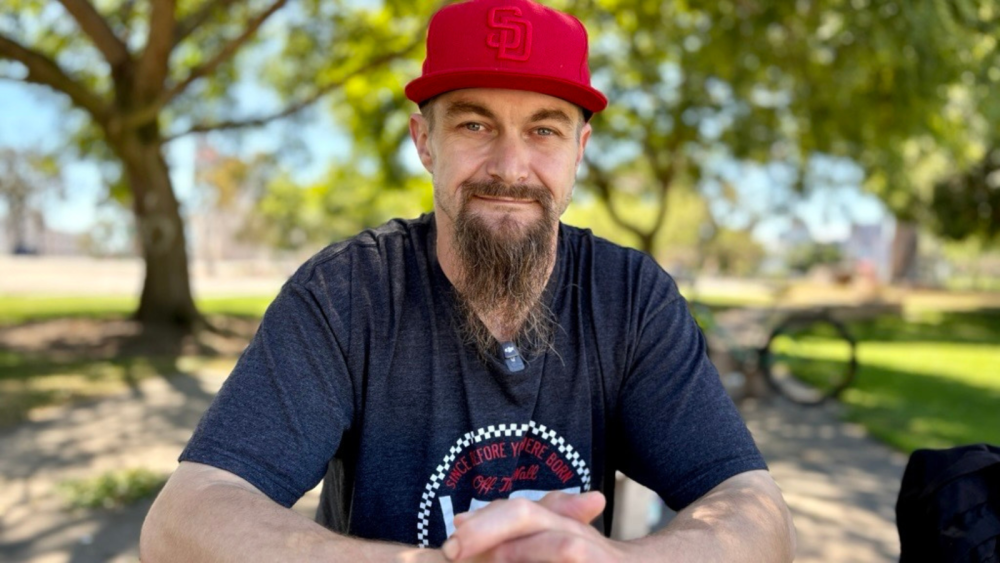One San Diegan Lived in the Riverbed for Years. Now Housed, He Plans to Help Others in Similar Situations

In late 2024, Michael Hook was taken to a resource fair designed to assist people experiencing homelessness in San Diego. These events are regularly held throughout the region and are coordinated by the City of San Diego to bring together local nonprofits and government agencies and deliver services meant to assist people transitioning out of homelessness.
Among the services offered are basic medical and dental care, mental health and substance abuse care connections, employment readiness assistance and even help with getting a new state identification card or benefits assistance.
Hook was seeking help from Homeless Court, a local partnership that offers alternative sentencing for those experiencing homelessness and facing misdemeanor charges.
“Something clicked and I was like, ‘No I can’t do this no more — I have to get it right,’” Hook said, recalling that moment.
That instance sparked Hook’s journey from homelessness to substance abuse treatment, then ultimately, housing. By his own recount, Hook said he spent at least five years living in and around the San Diego River near Mission Valley. Born and raised in East County, Hook, now 40, had previously experienced homelessness in his life, but nothing this long.
“I actually came to terms with being on the streets the rest of my life – and was okay with it,” Hook said. “I was like, ‘Well, this is the way life is going to be from now on.’ It doesn't have to be that way.”
Hook stayed in an area of the riverbed known as “the island” near Interstate 5 and Old Sea World Drive. In mid to late 2024, that area had dozens of encampments. The City received an Encampment Resolution Funding (ERF) grant from the State of California to conduct three months of outreach while offering sheltering opportunities to people living there, like Hook, before removing trash from remaining encampments.
All of the debris was removed in November 2024, with Hook and others connected to resources that met their specific need. For Hook, that included a short stay in the City’s Safe Sleeping Program, before being connected to a 21-day detox program.
“I learned a lot in those 21 days about myself and addiction and went to an outpatient program and learned even more,” Hook said.
Flash forward to today and Hook is celebrating ten months of sobriety and has his own housing downtown.
“I feel awesome,” Hook said. “Like I’ve never felt so good in my life. Turning 40 I feel awesome… Every day I wake up at like 6 a.m. without my alarm going off, just ready to rock and roll.”
During recovery, Hook enrolled in the nonprofit Kitchens for Good culinary program, where he learned technical skills needed for a career in hospitality. He now works at a restaurant in the kitchen and is eying a management position. He is also going to school to become a substance use disorder counselor, with the goal of helping people who are working to end their homelessness.
“I know a lot of people out there that want help, but they’re reluctant to get it because they’re scared of change or whatnot — even if they can’t admit it,” Hook said. “If you don’t witness it firsthand, I just feel like you may not grasp the idea of how hard it is. Because nothing is easy. Life's not easy, but being homeless is hard. It really puts a damper on your mind, body, spirit and everything, especially your sanity, especially if you’re on drugs.”
Hook and dozens of others who lived in the riverbed have similar stories. Through the state’s ERF grant, the City was able to contract with People Assisting the Homeless (PATH San Diego), National Alliance on Mental Illness (NAMI) San Diego and Healthcare in Action for outreach, case management and mobile medical care.
Hook admits he was not open to accepting resources initially but praised the PATH outreach workers and case managers who literally stayed on his case.
“She (PATH case manager) did an amazing job – she really did,” Hook said. “She was there helping me call, she called and talked to detox, she got me an Uber to detox — all that. She showed up the morning of to make sure I was awake to go to detox because she knew I wanted to go.”
The City’s and its partners’ work in the San Diego River area continues as part of a comprehensive approach to connect individuals to resources, remove encampments and address environmental concerns under the state ERF grant.
The funds were secured in 2023, in collaboration with the County of San Diego, to support the operation and provide dedicated, ongoing financial assistance to ensure stable options are available for people leaving encampments.
Since outreach began last year, 52 people have been connected to permanent housing and an additional 36 to sheltering programs. Others have received support, including medical care, substance abuse treatment and family reunification.
